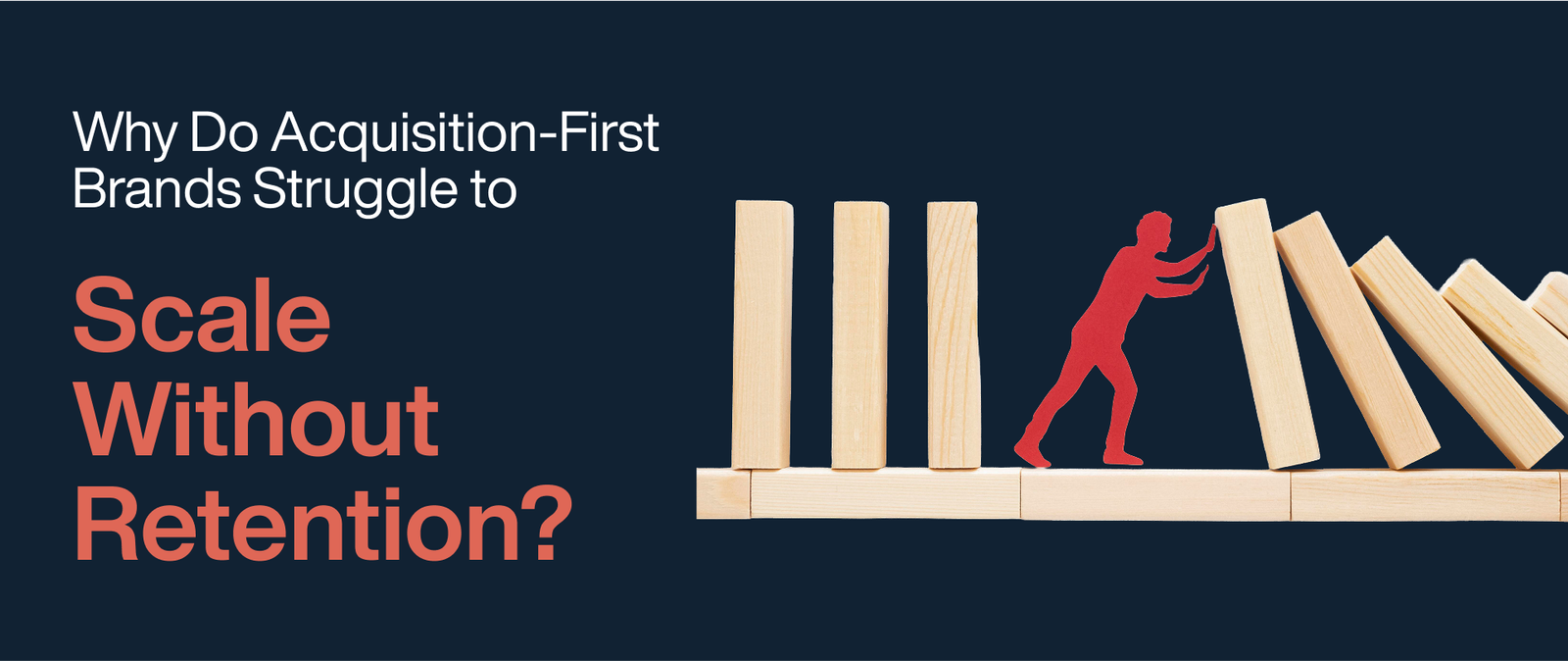Why Do Acquisition-First Brands Struggle to Scale Without Retention?

In the world of eCommerce, growth often feels like a race. Brands pour millions into Meta, Google, TikTok, or influencers, chasing the next wave of new customers. But here’s the truth: acquisition-first brands eventually hit a ceiling.
Without retention, scaling becomes expensive, unsustainable, and frustrating. Let’s break down why acquisition-only growth fails and why retention is the real engine behind profitable scaling.
The Acquisition Trap
At the early stage, acquisition seems to work. You spend $1 to acquire a customer, and they spend $2 or $3 with you. ROAS looks healthy, investors are happy, and revenue climbs.
But this model hides a dangerous flaw: customer churn.
If those new customers don’t come back, every month starts at zero. You are constantly re-buying the same revenue with higher ad costs.
That is why so many 7-figure brands struggle to make the leap to 8 figures. Their growth depends entirely on Facebook’s auction, Google’s algorithm, or TikTok’s volatility, none of which they control.
The Rising Cost of Acquisition
Over the past five years, customer acquisition costs (CAC) have skyrocketed. Privacy changes (iOS14, GDPR, CCPA), platform saturation, and increased competition mean that every click is more expensive.
For many DTC brands, CAC has doubled or tripled since 2020. Meanwhile, margins have not grown at the same rate.
This math simply does not work:
- CAC keeps going up
- Margins stay flat
- Without retention, profits go down
Scaling under these conditions is nearly impossible.
Why Retention Changes Everything
Retention flips the model on its head. Instead of starting each month with zero, you start with a base of loyal, repeat customers who already trust your brand.
Here is why it works:
Lower CAC dependency
Every returning customer reduces your reliance on paid ads. Instead of buying growth, you earn it.
Higher customer lifetime value (CLV)
A retained customer spends 3 to 5 times more over their lifetime. Increasing CLV by 25 percent can offset even a 50 percent rise in CAC.
Predictable revenue
With strong retention, you can forecast sales with accuracy. This stability makes scaling and fundraising much easier.
Stronger margins
Retention-driven sales do not require ad spend. That is pure incremental margin.
Retention as a Growth Multiplier
Retention does not replace acquisition. It multiplies its impact.
Imagine two brands:
- Brand A acquires 10,000 new customers monthly, but only 15 percent return.
- Brand B acquires 10,000 new customers monthly, but 40 percent return.
After 12 months, Brand A is stuck chasing the next 10,000. Brand B has compounded its base and built a powerful growth flywheel.
That is why brands like Apple, Nike, and Sephora dominate. Their acquisition spend fuels long-term loyalty, not one-time buyers.
Signs You Are Stuck in the Acquisition Trap
How do you know if your brand is scaling unsustainably? Look for these red flags:
- Low repeat purchase rate (RPR): Customers buy once, then disappear.
- Flat customer lifetime value (CLV): New revenue grows, but profitability does not.
- Heavy ad dependency: 70 to 80 percent of revenue comes from paid campaigns.
- High churn: Subscription cancellations or email unsubscribes outpace signups.
- Constant “revenue resets”: Every month feels like starting from scratch.
If this sounds familiar, you do not have a traffic problem. You have a retention problem.
How to Shift From Acquisition-First to Retention-First
Most brands think shifting to retention-first means simply sending more emails or launching a loyalty program. That is surface-level thinking. The real shift requires a systemic rebalancing of your growth model from how you allocate budget, to how you measure success, to how you build customer journeys.
Here is the expert-level strategy for making the shift:
Re-allocate Your Budget
- Instead of pouring 80 percent or more into acquisition (Meta, Google, TikTok), gradually move toward a 60/40 or 50/50 split where retention has equal priority.
- Retention investment covers lifecycle marketing (email, SMS, push), personalization tech, customer service, and loyalty mechanics.
- This shift ensures that the money you spend acquiring a customer is not wasted after one transaction.
Redefine Your Success Metrics
- Replace “CAC vs. ROAS” thinking with “LTV vs. CAC.”
- Focus on customer cohorts: how long do customers stay, how much do they spend, how often do they return?
- Track payback period (how fast you recover acquisition spend) and build campaigns to shorten it.
Redesign the Customer Journey
- Stop treating post-purchase as an afterthought. Map day 0 to day 365 for every customer segment.
- Build structured flows: onboarding (welcome series), repeat-driving (post-purchase and cross-sell), retention (win-back, replenishment), and loyalty nurturing.
- Create predictive retention triggers: identify signals of churn (for example, no activity in 30 days) and intervene early.
Integrate Acquisition and Retention Teams
- Eliminate silos. Acquisition learns which segments bring the highest LTV, and optimizes ads toward them. Retention feeds back real data on which customers stick.
- Create a shared growth dashboard so both teams work toward LTV growth, not just volume.
Adopt a Compounding Growth Mindset
- Acquisition is a one-time spike. Retention is compounding growth. Each repeat purchase lowers your effective CAC and raises margins.
- Think in terms of customer equity (the value of your customer base as an asset). When retention improves, acquisition dollars multiply in value.
The bottom line:
Shifting to retention-first does not mean ignoring acquisition. It means building a growth engine where every new customer is nurtured, maximized, and kept instead of lost to churn. Brands that master this balance create sustainable, predictable growth that compounds year over year.